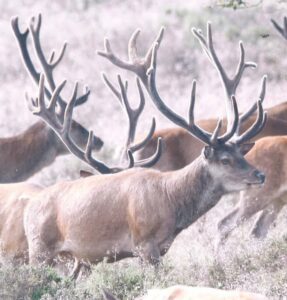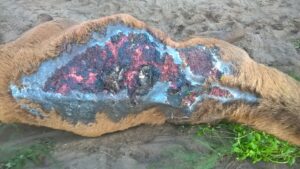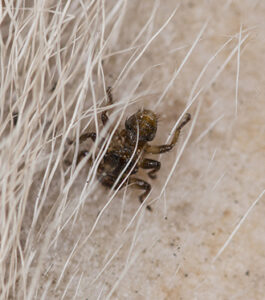

In October 2016 the cadaver of a red deer stag with extensive damage to the skin of the back was submitted to the DWHC. Investigations revealed a severe chronic-active dermatitis (inflammation of the skin) which was possibly a result of self-trauma due to itchiness caused by the large number of deer keds (biting louse flies) found on the animal.
Forestry and wildlife wardens have been monitoring the red deer in this area for several years and often record their observations in a photo archive. Thanks to this data it was possible to trace the development of the skin lesion over several years: According to forestry warden Han ten Seldam this animal had been nicknamed ‘de Vlek’ on account of the bloody area of about 25 cm in diameter on its flank that was first noticed in September 2010. Prior to this, a lump had been seen in that area and Ten Seldam believes that it was painful as the animal was repeatedly seen to bother it with its snout. Since then the area remained bald with a scab that occasionally opened up. In May 2016 it was no larger than it had been in 2010 and the wardens had no reason to suspect that it would spread across the rest of the back. In October 2016 when the extent of the lesion was seen, the stag was euthanized and submitted to the DWHC.
 |
 |
| The lesion in 2010; Photo: W. Ouwendijk | The lesion in May 2011; Photo: E.J. Veenendaal |
 |
| The skin lesion, October 2016; Photo: H. ten Seldam |
Almost all of the skin of the back was affected and bleeding in many places. Hundreds of deer ked were found all over the hide. Scabies mites (Sarcopties scabeii) were NOT found. The Bartonella schoenbuchensis bacteria was found on the skin and in the spleen. Internally the stag had an abscess in the abdominal cavity which is thought to be the result of an old wound.
Severe infestation with large numbers of deer keds is known to cause distress and itchiness causing animals to scratch at the skin, often drawing blood (self trauma). However, whilst deer ked are relatively common, such extensive skin damage is very rarely seen so it seems likely that another as yet unknown factor was involved in the development of this lesion.
It is possible that the stag’s immune system was weakened by the abscess whereby the inflammation caused by the deer keds could spread across the back. It is unclear as to whether the bacteria that were found on the skin were involved in the inflammation. Bartonella bacteria are known to cause skin inflammation in humans but this has not previously been described in deer. Deer and elk often have antibodies to this sort of bacteria and it is unknown as to whether these bacteria can cause disease in these species. It is possible that if the stag’s immunity was weakened by the abscess, the bacteria were able to multiply rapidly, thereby contributing to the spread of the skin lesion. Unfortunately, based on the results of the postmortem investigation it is not possible to say whether the bacteria played a role in this case.
The pathologists have concluded that the skin inflammation was most likely the result of self-trauma induced by the extraordinarily large numbers of deer keds found on this animal. The possibility that other factors were involved has not been ruled out.
 |
 |
| Deer keds were seen all over the hide; Photo: Multimedia, Veterinary faculty | Deer ked; Photo: Multimedia, Veterinary faculty |